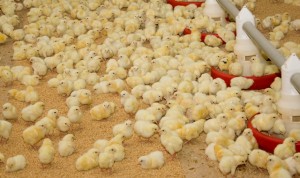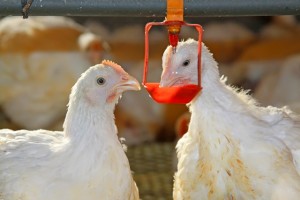Poultry Diseases
Infectious Bronchitis in Chickens
Different serotypes and genetic types of the virus have been identified worldwide, and for the most part do not cross protect (Jackwood, 2012). The virus is present in both commercial and backyard chickens. The recent discoveries of IBV and IBV-like strains in species of birds other than the chicken (Cavanagh, 2005), such as geese, ducks, and pigeons, might also play a role in the spread of IBV strains over the world.
Specific IBV strains able to infect another bird species, especially if it is a migratory bird, spread more easily over long distances than strains that do not replicate in that bird species (Wit et al., 2011). The virus is shed via both the respiratory tract and feces, and can persist in the birds intestinal tract for several weeks or months (Wit et al., 2011). Surveillance and identification of IBV types is extremely important for control of the disease as new types of the virus continue to arise due to mutations and recombination events in the viral genome, making this virus difficult to identify.
Collectively the adverse effects make IB the biggest single cause of infectious disease-related economic loss in the United Kingdom, and probably in other countries that have a similar disease spectrum and control measures as in the UK (Cavanagh, 2007) IB costs the U.S. poultry industry millions of dollars annually and it remains one of the top research priorities for commercial poultry worldwide (Jackwood, 2009).
The disease spreads very rapidly, and all birds in an infected flock tend to become infected. The production losses from IB are greater than those from mortalities (Cavanagh and Nyaqi, 1997). Annual mortalities recorded in the UK rarely reach more than 30% per annum (Bennett et al., 1999). Recovered laying birds may never regain pre-infection production rates.
Clinical Signs of Infectious Bronchitis

Infectious Bronchitis is a global virus that affects both commercial and backyard chickens, and it is often the young chicks who are most severely affected.
Young chicks are most severely affected, although all age groups are susceptible. Typically, the disease results in respiratory signs such as coughing, sneezing and rattling and occasionally facial swelling in young chicks. These symptoms usually manifest 18-24 hours post-exposure and may last for about 2-3 weeks.
In adult birds, feed consumption and egg production tend to decrease sharply. The disease may damage the reproductive tract and cause a reduction in egg production, with misshapen, ridged and thin soft eggs of poor internal quality.
On post-mortem, catarrhal lesions in the respiratory tract and, in some cases, lesions in the reproductive tract of infected adults can be seen. Air sacs may be thickened and cloudy. Although the clinical symptoms and histopathology are suggestive of the disease, they may also be indicative of other respiratory pathogens. Detection of antibodies or demonstration of the virus in sera or in embryonic culture provide diagnostic evidence. Detection of the virus is easiest during the early stages of infection.
The disease is spread by droplet infection through the air, from bird to bird. Although the frequency of airborne transmission is not known, there is some evidence of transmission over 1Km (cited by Cavanagh and Nyaqi, 1997). The virus may also be spread by contaminated material and equipment, and via feces (Cavanagh, 2007).
There is also some evidence that point of lay may result in excretion of the virus, which may previously have been dormant in a host bird. An association between the occurrence of infectious bronchitis and an increased risk of feather pecking in free-range systems has been identified although the direction of the association is unclear (Green et al., 2000).
There may also be a breed factor, with some heavier birds being more susceptible, though this may be related to the immune response (Cavanagh, 2007).
Control and Prevention of Infectious Bronchitis
Prevention of IB, and other respiratory diseases, requires an environment that reduces potential damage to the respiratory tract. Prevention is best achieved through good management by creating draft free environments, good ventilation and optimal temperature. Of these, the most important requirement is good ventilation, which should provide oxygen, reduce the concentration of airborne pathogens, and remove excess moisture, toxic and harmful gases. The virus outside the body of the host is killed by disinfection under most farm conditions. Excessive environmental ammonia and sub-optimal brooding temperatures can increase the severity of the disease.
Vaccinating Against Infectious Bronchitis
Immunity may be developed as a result of exposure or vaccination, or through maternal immunity. Both live and inactivated vaccines are available and are used extensively. Live vaccines induce a mild respiratory condition. Vaccines are normally applied in drinking water or as a spray. If day old birds are vaccinated against IB, it will block initial field infection until active immunity is generated by the circulating persisting virus.
The disease can be transmitted very long distances (over 1 Km) by airborne transmission, and so producers may choose to vaccinate if they are situated close to other poultry farms from which the disease may spread.
Recovered birds are immune, but are carriers of the disease. The disease will only recur if birds are put under respiratory stress – e.g. housed with poor ventilation.
Treating Infectious Bronchitis
There is no specific treatment, although supportive treatment with antibiotics to control secondary infection could be beneficial. The rate of spread can be very rapid and therefore infected flocks should be isolated to prevent the spread of disease. Supportive treatment, such as increasing the temperature of the house by 3-4°C may reduce mortality rates in infected flocks. Secondary infections that occur as a result of IB are generally more of an issue than the IB itself.
Good Practice Based on Current Knowledge
- Vaccinate birds at a day old
- An “all-in/all-out” management policy should be followed, with disinfection between batches
- Ensure houses are well-ventilated but draft-free
- Ensure houses are free from ammonia build-up and toxic gases
- Avoid multiple age groups of birds to avoid the inter-group spread of disease
- Ensure houses are rat-free


 British English
British English


Comments are closed.